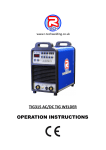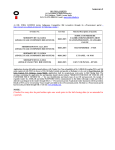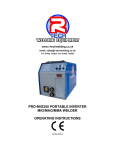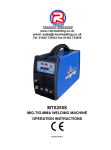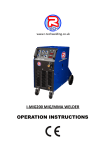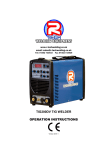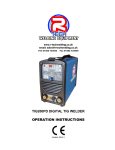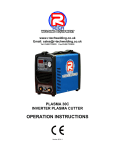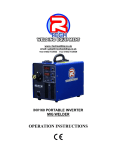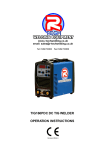Download R-Tech C-MIG 315 Specifications
Transcript
www.r-techwelding.co.uk email: [email protected] Tel: 01452 733933 Fax 01452 733939 C-MIG 315 COMPACT MIG WELDING MACHINE OPERATION INSTRUCTIONS Version 2014-1 2 3 Thank you for selecting the R-Tech C-MIG 315 Compact Mig Welder. We want you to take pride in operating our C-MIG 315 as much pride as we have taken in making this product for you. PLEASE EXAMINE CARTON AND EQUIPMENT FOR DAMAGE IMMEDIATELY When this equipment is shipped, title passes to the purchaser upon receipt from the courier. Consequently all claims for material damaged in shipment must be made by purchaser against the transportation company used. Please record your equipment identification below for future reference. This information can be found on data plate at rear of machine. Product C-MIG315 Serial No. ___________________________________ Date of Purchase _____________________________ Where Purchased _____________________________ Whenever you request replacement parts or information on this equipment please always supply information you have recorded above This product is covered by 2 years collect and return UK warranty, R-Tech will cover cost of collection, repair and return of item to UK mainland (other areas are RTB). External items, torch, earth lead etc are covered by 3 months warranty. Any faults/damage found caused by customer will be charged pro-rata. Please read this operator manual completely before attempting to use this equipment. Pay particular attention to the safety instructions we have provided you for your protection The level of seriousness to be applied to each section is explained below WARNING This statement appears where the information must be followed exactly to avoid serious personal injury. CAUTION This statement appears where the information must be following to avoid a minor personal injury or damage to this equipment. 4 Installation Technical Specifications Model No. R-Tech C-MIG 315 Input MIG Operation 415V 3 ~ AC 50/60Hz Rated Input Power Rated Input Current Rated Output Current Duty Cycle @ 315AMPS Duty Cycle @ 200AMPS Output current Range No Load Voltage Voltage Adjustment Range Suitable Wire Diameter Gross Weight Insulation 6.2 KVA 18 AMPS 315 AMPS 40% @ 40ºC 100% @ 40ºC 40-315 AMPS 38V MAX 16V – 33V +/- 3V 0.8mm 1.0mm 1.2mm 82 KG Class F Safety Precautions Read entire section before starting installation WARNING! Electric Shock can kill – Only qualified personnel should perform this installation. Turn off input power at the fuse box before working on this equipment. Do not touch electrically live parts. Always connect the machine to an earthed mains supply as per national recommended standards. Select suitable location Place the welder where clean cooling air can freely circulate in and out of the front & rear louver vents. Dirt, dust or any foreign material that can be drawn through vents into welder must be kept to a minimum. Failure to observe these precautions can result in excessive operating temperatures which can lead to plant failure. Grinding Do not direct grinding particles towards the welder. An abundance of conductive material can cause plant failure. Stacking This machine cannot be stacked. 5 Transport – Unloading Never underestimate the weight of equipment, never move or leave suspended in the air above people. Use recommended lifting equipment at all times. WARNING! Falling Equipment can cause injury. Never lift welder with gas bottle attached. Never lift above personnel. Tilting Machine must be placed on a secure level surface or on a recommended undercarriage/trolley. This machine may topple over if this procedure is not followed. Environmental Rating The welding power source carries the IP21S rating. It may be used in normal industrial and commercial environments. Avoid using in areas where water / rain is around. Read and follow the ‘Electric Shock Warnings’ in the safety section if welding must be performed under electrically hazardous conditions such as welding in wet areas or water on the work piece. Machine grounding and High Frequency Interference Protection This welder must be grounded to earth. See national electrical codes fro proper grounding methods. The high frequency generator being similar to a radio transmitter may cause interference to radio, TV and other electronic equipment. These problems may be the result of radiated interference. Proper grounding methods can reduce or eliminate this. Radiated interference can develop in the following ways 1. 2. 3. 4. Direct interference from welder power source Direct interference from the welding leads Direct interference radiated from feedback into power lines Interference from re-radiation by un-grounded metallic objects. Keeping these contributing factors in mind, installing equipment as per following instructions should minimize problems. 1. Keep the welder input power lines as short as possible and enclose as much of them as possible in metal conduit or equivalent shielding. There should be a good electrical contact between this conduit and ground (Earth). 2. Keep the work and electrode leads as short as possible. Tape the leads together where practical. 3. Be sure the torch and earth leads rubber coverings are free from cuts and cracks that allow welding power leakage 6 4. Keep earth lead connection to work in good condition – Clean area on workbench where earth clamp is situated on a regular basis. Input Connections Make sure the voltage, phase and frequency of input power is as specified on machine rating plate located at rear of machine. Have a qualified electrician provide suitable input power as per national electrical codes. Make sure machine is earthed / grounded. Make sure fuse or circuit breaker is correct rating for machine. Using fuses or circuit breakers smaller than recommended will result in ‘nuisance’ shut off from welder inrush currents even if welding at low amperages. On multiple voltage input welders, be sure the machine is connected as per the instructions for the voltage being supplied to welder – Failure to follow these instructions can cause immediate failure within the welder and void machines warranty. WARNING! ELECTRIC SHOCK CAN KILL Turn the input power OFF at the mains switch & fuse box before working on this equipment. Have a qualified electrician install & service this equipment. Allow machine to sit for 5 minutes minimum to allow the power capacitors to discharge before working inside this equipment. Do not touch electrically live parts The C-MIG 315 Mig Welder requires a 415V 50/60Hz 3-Phase supply. It requires an 18A supply. It comes with a 3 metre mains cable attached. Connect wires according to national coding. Brown wire – Live Blue wire – Live Black wire - Live Green/Yellow Wire – Earth (Ground) 7 Connections for C-Mig 315 Setup machine as per two diagrams below: Rear machine connections Front machine connections Connect Euro type Mig torch to euro torch connector To avoid shock keep the Mig torch in good condition and replace if any of the insulation is damaged. Connect the earth lead (negative - ) to work/bench. Connect the gas input hose to gas regulator, Set gas flow/pressure to 10-14 LPM, in drafty or open areas a higher flow may be required to stop porosity of weld. Make sure gas bottle is secured machine securely to avoid injury. 8 Operation SAFETY PRECAUTIONS WARNING! ELECTRIC SHOCK CAN KILL Do not touch electrically live parts or electrode with skin or wet clothing. Insulate yourself from work and ground Always wear dry insulating gloves WARNING! FUMES AND GASES can be dangerous Keep your head out of fumes & gases produced from welding. Use ventilation or exhaust to remove fumes & gases from breathing zone and general area. WARNING! WELDING SPARKS can cause fire or explosion Keep flammable material away from work area. Do not weld on containers that have held combustibles WARNING! ARC RAYS can burn Wear eye, ear and body protection – Make sure work area is protected by proper shielding to avoid injury to passers by. Product Description The R-Tech MIG is a member of our field acclaimed family of welding products. Premium features include:1. 40% Duty cycle at 315Amps @ 40ºC 2. Heavy Duty 4-Roll geared wire feed unit for long working life and consistent wire feeding. 3. 21 settings of welding voltage to allow fine tuning of weld characteristics 9 4. 5. 6. 7. Adjustable burnback control Spot Welding & stitch welding facilities Digital Amp & Volts meters Euro type torch fittings for easy torch fitment/replacement Recommended Processes The R-Tech C-MIG315 is recommended for the MIG welding processes within its output capacity of 315 Amps DC Equipment Limitations The R-Tech C-MIG 315 is protected from overloads beyond the output ratings and duty cycle as per machine specifications with thermostat protection of the output coils and rectifiers. Welding Capability – Duty Cycle The R-Tech C-MIG 315 is rated at 315 Amps at 40% duty cycle on a ten minute basis. If the duty cycle is exceeded a thermal protector will shut machine off until the machine cools. Controls and Settings Front Panel 10 Set required voltage for welding material – Coarse voltage is set via 3 position switch either low, medium or high range – Fine adjust is set via 7 position switch. Adjust wire feed speed to suit voltage/wire diameter chosen. Current LED shows actual welding voltage when welding Voltage LED shows actual welding voltage when welding Spot Timer – Sets how long spot weld will be Stitch Time – Sets interval of stitch weld time Power switch – Turns machine on/off Power light – lights when machine turned on Warning Light – lights when fault occurs (Overworking of machine – overheating) Rear Panel 15 Amp Fuse – Protection fuse for 110V auxiliary 110V Aux - 110V Auxiliary output for water cooling system etc. 11 Side panel Burnback adjustment – This sets amount of time welding power stays on after torch button released and wire feed has stopped. If too little Burnback is set, wire may stick to work after trigger released, if too much Burnback is set wire will Burnback into welding tip. Wire reel holder – remove retainer screw cap and fit wire reel and refit securing screw cap. The reel holder features an internal adjustable breaking system so that reel of wire stops quickly when torch trigger released, other wise wire reel would continue for a few seconds causing wire to come of sides of reel and cause tangle (birds nest) Wire feed assy – make sure rollers are correct size for wire diameter selected, to change rollers release retaining knurled head screw fit rollers onto shafts making sure the right size groove is in line with wire and refit retaining screws. Do not over tighten wire feed pressure rollers as this can cause premature motor and roller failure. TIP: Correct way to adjust tensioners is to slacken off pressure so that wire does not feed, slowly adjust pressure until wire feeds smoothly, you should be able to stop wire feeding by holding wire and it should slip on rollers. If you have too little pressure wire will slip when welding causing unwanted Burnback into tips, if you have too much pressure wire can snag in rollers when wire hits work and cause wire tangle by rollers. Welding operation Once you have set machine up as per above instructions press the torch trigger to start welding, gas will flow from torch and main welding power will start and wire feed will start and once wire has touched workpiece welding will start, to stop welding release torch trigger. Adjust wire feed speed to give desired weld characteristics – Less wire = Dip transfer welding More wire = Spray transfer welding TIP: Inside wire feed lid is chart with approximate recommended welding power settings required for various sizes of material. Chart also shown below 12 13 Maintenance Routine and periodic maintenance WARNING! ELECTRIC SHOCK CAN KILL Turn the input power OFF at the mains switch & fuse box before working on this equipment. Have a qualified electrician install & service this equipment. Allow machine to sit for 5 minutes minimum to allow the power capacitors to discharge before working inside this equipment. Do not touch electrically live parts 1. Periodically remove the side/top panels of machine and clean out machine with a low pressure dry air line paying particular attention to PC Boards, Fan blades, HF points 2. Inspect input and output cables & hoses for fraying, cuts & bare spots 3. Keep tig torch and cables in good condition 4. Clean air vents to ensure proper air flow and cooling 5. The fan motor has sealed bearings which requires no maintenance Troubleshooting Service & repair should only be performed by R-Tech welding trained personnel. Unauthorized repairs performed on this equipment may result in danger to the technician and machine operator and will invalidate your warranty. For your safety and to avoid electric shock, please observe all safety notes and precautions detailed throughout this manual The troubleshooting guide is provided to help you locate possible machine malfunctions. Simply follow the 3 step procedure below Step 1 Locate problem (symptom) Look under the column labeled ‘Problem (symptoms)’. This column describes possible symptoms that the machine may exhibit. Find the listing that best describes the symptom that the machine is exhibiting Step 2 Possible Cause 14 The second column labeled ‘possible cause’ lists the obvious external possibilities that may contribute to the machine symptom Step 3 Recommended course of action This column provides a course of action for the possible cause, generally it states to contact R-Tech welding for repair of machine. Output Problems Problems Machine is dead – No Output – No fan Symptoms 1 Make sure the input switch is in the ‘ON ‘ position 2 Check the input voltage at the machine. Input voltage must match the rating plate. Refer to installation in this manual. Fan runs normally at power up – No output from machine Fan runs –No output form machine and the warning light on control panel is lit. Fan runs – Machine does not respond to torch switch. Problems Machine regularly overheats – warning light on front panel lit. Fan runs but machine has no output 3 Blown or missing fuses on mains input. Check for proper input voltages as per rating plate. Welding application may have exceeded recommended duty cycle. Allow the unit to run until fans cools the welder and the light goes out. The torch switch is faulty. Check for continuity on torch trigger wires or replace torch. If torch is working then suspect PCB failure or broken wiring. Symptoms 1 Welding application may exceed recommended duty cycle – Reduce the duty cycle of job. 2 Dirt and dust may have clogged the cooling vents. Blow out machine with dry, clean low pressure air. 3 Air vents may be blocked due to inadequate clearance around machine Rec. Course of action If all recommended areas of fault have been checked and problem persists, Contact R-Tech Welding for repair. As Above As Above As Above Rec. Course of action If all recommended areas of fault have been checked and problem persists, Contact R-Tech Welding for repair. 15 Mig Weld Problems No gas flow when torch switch activated. Machine has output and fan runs. A click can be heard indicating gas solenoid is operating Poor weld penetration Porosity in weld 1 Gas supply is empty or turned off 2 Flow regulator may be set too low 3 Gas hose may be pinched 4 Gas pipe blocked. Blow out with low pressure air line Check condition of earth lead & clamp and make sure it is fitted to clean area on bench/workpiece. Check gas flow from torch tip, if you cant get enough gas flow, adjust gas regulator flow if bottle has gas check torch for gas restriction – try replacing torch If all recommended areas of fault have been checked and problem persists, Contact R-Tech Welding for repair. If all recommended areas of fault have been checked and problem persists, Contact R-Tech Welding for repair. If all recommended areas of fault have been checked and problem persists, Contact R-Tech Welding for repair. 16 Electrical Schematic Diagram 17 Wiring Diagram 18 19



















